Moroccan music varies greatly between geographic regions and social groups. It is influenced by musical styles including Arab, Berber, Andalusi, Mediterranean, Saharan, West African, and others.

Agadir is a major city in Morocco, on the shore of the Atlantic Ocean near the foot of the Atlas Mountains, just north of the point where the Souss River flows into the ocean, and 509 kilometres (316 mi) south of Casablanca. Agadir is the capital of the Agadir Ida-U-Tanan Prefecture and of the Souss-Massa economic region.
Tamazgha is a fictitious entity and neologism in the Berber languages denoting the lands traditionally inhabited by the Berber peoples within the Maghreb. The term was coined in the 1970s by the Berber Academy in France and, since the late 1990s, has gained particular significance among speakers of Berber languages. Although Berberists see Tamazgha as the geographic embodiment of a Berber imaginary of a once unified language and culture that had its own territory, it has never been a single political entity, and Berbers across the Maghreb did not see themselves as a single cultural or linguistic unit, nor was there a greater "Berber community" due to their differing cultures and languages. Despite this, certain Berberists such as members of the Algerian separatist Movement for the Self-Determination of Kabylia use the term to imagine and describe a hypothetical federation spanning between the Canary Islands and the Siwa Oasis, a large swathe of territory including Morocco, Algeria, Tunisia, Libya, Mauritania, Mali, Niger, Egypt, the Western Sahara, Burkina Faso and Senegal.
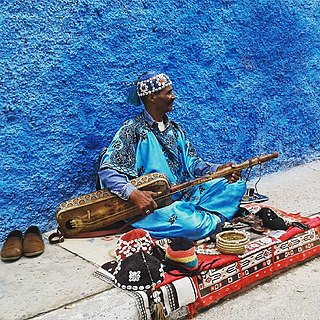
The Gnawa are an ethnic group inhabiting Morocco, that had been brought as slaves from West African Sahel, especially northern Nigeria.
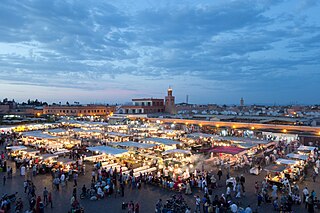
Jemaa el-Fnaa is a square and market place in Marrakesh's medina quarter. It remains the main square of Marrakesh, used by locals and tourists.
Malhun, meaning "the melodic poem", is a form of music that originated in Morocco. It is a kind of urban, sung poetry that comes from the exclusively masculine working-class milieu of craftsmen's guilds. On 6 December 2023, malhun was added to the UNESCO Intangible Cultural Heritage Lists of Morocco.

The culture of Morocco is a blend of Arab, Berber, Andalusi cultures, with Mediterranean, Hebraic and African influences. It represents and is shaped by a convergence of influences throughout history. This sphere may include, among others, the fields of personal or collective behaviors, language, customs, knowledge, beliefs, arts, legislation, gastronomy, music, poetry, architecture, etc. While Morocco started to be stably predominantly Sunni Muslim starting from 9th–10th century AD, during the Almoravid period, a very significant Andalusi culture was imported, contributing to the shaping of Moroccan culture. Another major influx of Andalusi culture was brought by Andalusis with them following their expulsion from Al-Andalus to North Africa after the Reconquista. In antiquity, starting from the second century A.D and up to the seventh, a rural Donatist Christianity was present, along an urban still-in-the-making Roman Catholicism. All of the cultural super strata tend to rely on a multi-millennial aboriginal Berber substratum still present and dating back to prehistoric times.
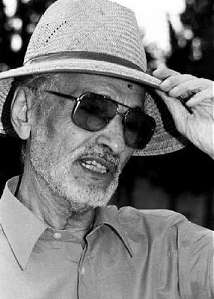
Mohamed Chafik, born 17 September 1926, is a leading figure in the Amazigh cultural movement. An original author of the Amazigh Manifesto, he was later appointed as the first Rector of the Royal Institute of the Amazigh Culture. He has worked extensively on incorporating Amazigh culture into Moroccan identity and is a leading intellectual of the Moroccan intelligentsia.

Hoba Hoba Spirit is a musical fusion band based in Casablanca, Morocco that was formed in 1998. It is composed of Adil Hanine (drummer), Anouar Zehouani (guitarist), Saâd Bouidi, Reda Allali - and Othmane Hmimar(percussionist). The name of the group is based on a song by Bob Marley.

Fantasia is a traditional exhibition of horsemanship in the Maghreb performed during cultural festivals and for Maghrebi wedding celebrations. It is present in Algeria, Libya, Mali, Mauritania, Morocco, Niger and Tunisia. It is attested in the ancient Numidian times during which it was practiced by the Numidian cavalry. Historian Carlos Henriques Pereira stated that the North African fantasia also called barud is a modern watered down version of a Numidian military technique.
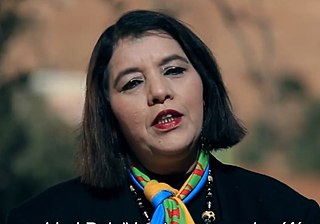
Fatima Tabaamrant is a Moroccan Amazigh actress and singer-songwriter. She sings and performs in her native Amazigh tongue.

There are a number of languages in Morocco. De jure, the two official languages are Standard Arabic and Standard Moroccan Berber. Moroccan Arabic is by far the primary spoken vernacular and lingua franca, whereas Berber languages serve as vernaculars for significant portions of the country. The languages of prestige in Morocco are Arabic in its Classical and Modern Standard Forms and sometimes French, the latter of which serves as a second language for approximately 33% of Moroccans. According to a 2000–2002 survey done by Moha Ennaji, author of Multilingualism, Cultural Identity, and Education in Morocco, "there is a general agreement that Standard Arabic, Moroccan Arabic, and Berber are the national languages." Ennaji also concluded "This survey confirms the idea that multilingualism in Morocco is a vivid sociolinguistic phenomenon, which is favored by many people."
Dr. Michael Peyron is a specialist in the field of Berber language, literature and culture. He is also well known as a writer on tourism in Morocco.

Sefrou is a city in central Morocco situated in the Fès-Meknès region. It recorded a population of 79,887 in the 2014 Moroccan census, up from 63,872 in the 2004 census.

Ammouri M'barek was the renovator of the Moroccan Amazigh (Berber) Music, was born in 1951 in Irguiten, a small village located at the bottom of the High Atlas near Taroudannt town, in Taroudannt Province, Morocco.

The National Library of the Kingdom of Morocco is located in Rabat, Morocco, with a branch in Tetouan. The former Bibliothèque Générale was created in 1924. In 2003, it was renamed the "Bibliothèque nationale du Royaume du Maroc."
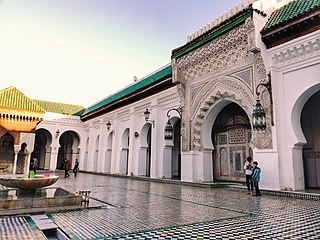
Fez or Fes is a city in northern inland Morocco and the capital of the Fès-Meknès administrative region. It is the second largest city in Morocco, with a population of 1.11 million, according to the 2014 census. Located to the northwest of the Atlas Mountains, it is surrounded by hills and the old city is centered around the Fez River flowing from west to east. Fez has been called the "Mecca of the West" and the "Athens of Africa". It is also considered the spiritual and cultural capital of Morocco.
Brahim Akhiat was a Moroccan author and poet, and a Berber activist.
Anarchism in Morocco has its roots in the federalism practiced by Amazigh communities in pre-colonial Morocco. During the Spanish Civil War, Moroccan nationalists formed connections with Spanish anarchists in an attempt to ignite a war of national liberation against Spanish colonialism, but this effort was not successful. Despite the brief establishment of an anarchist movement in post-war Morocco, the movement was suppressed by the newly independent government, before finally reemerging in the 21st century.

Visa for Music is a performing arts festival and professional marketplace for contemporary music from Africa and the Middle East. Its activities are addressing both professionals in the cultural and creative industries as well as the general public. For four days in November of each year, Visa for Music has been taking place since 2014 in Rabat, the capital of Morocco. Both applications by artists as well as numbers of professional attendees and public audiences have been increasing over the years, reaching more than 16,000 participants in 2022.















